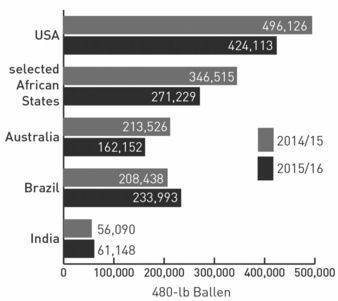15.12.16 – Thailand
Economic recovery leads to increasing cotton imports
MY2016/17 Thai cotton imports are forecasted to increase to around 1.4 million bales, up approximately 6 percent from MY2015/16. Thai spinning mills are expected to recover from the economic downturn over the past couple of years in anticipation of a sustained economic recovery in 2016-2017.
MY2016/17 imports of U.S. cotton are expected to increase to 450,000 bales, up 6 percent from MY2015/16. Large-scale spinning mills which account for approximately 60 percent of total cotton yarn production still maintain their competitive edge in domestic and export markets as they have invested in new machinery and improved their production efficiency. However, competition from cheaper yarn imports from Vietnam and India will likely remain a challenge to domestic yarn producers, particularly for small-scale spinning mills.
MY2015/16 cotton imports were lower than expected at around 1.3 million bales, down 13 percent from MY2014/15. This reflected a reduction in cotton and cotton-blended yarn production which declined approximately 5 percent as spinning mills were forced to hold large inventories of yarn. Imports of cotton yarn increased 44 percent from MY2014/15 with cotton yarn imports from Vietnam and India doubling. Additionally, exports of cotton yarn declined 28 percent from the previous year, particularly to China and Japan due to an economic slowdown and competition from Vietnam. These two countries accounted for approximately 70 percent of total cotton yarn exports from Thailand.
MY2015/16 imports of U.S. cotton declined to 424,113 bales, down 15 percent from MY2014/15 However, U.S. cotton still maintained its market share accounting for approximately one third of total cotton import demand. Meanwhile, medium-scale spinners who limited their purchases to cheap cotton to maintain their operations imported more Brazilian cotton. Imports of Brazilian cotton increased significantly to 233,993 bales, up 12 percent from the previous year. Brazil’s market share increased to 18 percent of total cotton imports, compared to 8 percent in MY2014/15 at the expense of Australian and African cotton imports.
Source: USDA FAS* GAIN Report, Nov. 25, 2016
The Foreign Agricultural Service (FAS)* of USDA has staff in 99 offices in 80 countries around the world. FAS foreign service officers and foreign nationals also monitor and report on agricultural trade issues in an additional 66 countries. FAS overseas offices provide information on international production, consumption, and trade of most commodities of interest to U.S. agricultural producers. It should be noted that production, supply, and distribution data contained in GAIN are not official USDA data, but represent estimates made by FAS Attachés.
Extract from Bremen Cotton Report 47/48, December 08, 2016, authorized by the Bremen Cotton Exchange - www.baumwollboerse.de

